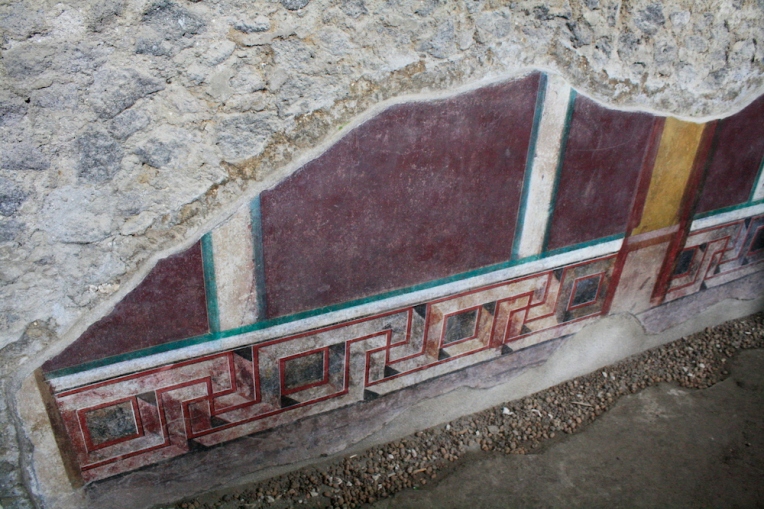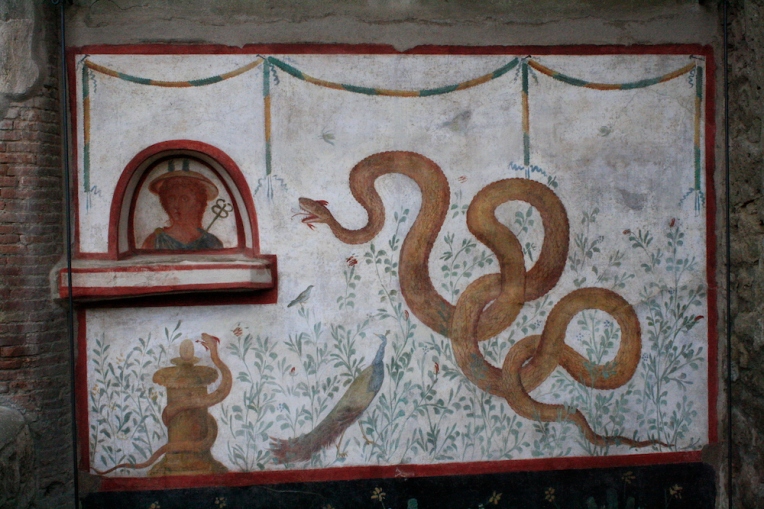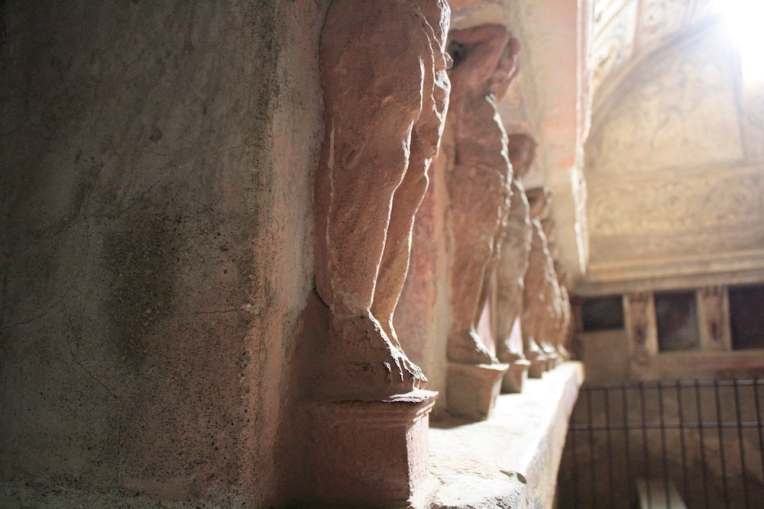I knew a little, tiny bit about Pompeii before…let’s see, there was a town and it was destroyed by a volcano…yep, that’s about it (unless you count the knowledge that the Tenth Doctor visited once and saved the man who would eventually become the inspiration for the face of the Twelfth Doctor…if you don’t know what I’m talking about, go watch Doctor Who right now…no delays!).
So I guess you could say that I went in not knowing a great deal about Pompeii, and there is not much I can actually say about going to Pompeii other than this – take a map of the ruins…and possibly a history book…because there aren’t many placards along the way to let you know what you’re looking at. Believe me, this blog took a lot longer to publish because I had to research almost everything (I think it’s their way of getting you to buy the audio guide…which I now highly recommend).
All that aside, actually stepping into the ruins, you realize it was not just a few hovels, huts, or even houses crammed together, but rather a thriving Roman city…with two theatres and an amphitheatre (although the small theatre was not open to the public on the day we visited). It’s really difficult to imagine (but rather easy to see) that you are walking the streets of a town frozen in time…August 24th, 79AD to be exact.
I’m going to start this blog how I should have started my trip, with a brief, brief history lesson from my favorite site for quick info…Wikipedia. The Wikipedia site on Pompeii has this to say…
Pompeii was an ancient Roman town-city near modern Naples, in the Campania region of Italy, in the territory of the commune of Pompeii. Pompeii, along with Herculaneum and many villas in the surrounding area, was mostly destroyed and buried under 4 to 6 m (13 to 20 ft) of volcanic ash and pumice in the eruption of Mount Vesuvius in AD 79.
Researchers believe that the town was founded in the seventh or sixth century BC by the Osci or Oscans. It came under the domination of Rome in the 4th century BC, and was conquered and became a Roman colony in 80 BC after it joined an unsuccessful rebellion against the Roman Republic. By the time of its destruction, 160 years later, its population was estimated at 11,000 people, and the city had a complex water system, an amphitheatre, gymnasium, and a port. (they forgot to mention Pompeii’s TWO theatres!)
The eruption destroyed the city, killing its inhabitants and burying it under tons of ash. Evidence for the destruction originally came from a surviving letter by Pliny the Younger, who saw the eruption from a distance and described the death of his uncle Pliny the Elder, an admiral of the Roman fleet, who tried to rescue citizens. The site was lost for about 1,500 years until its initial rediscovery in 1599 and broader rediscovery almost 150 years later by Spanish engineer Rocque Joaquin de Alcubierre in 1748. The objects that lay beneath the city have been preserved for centuries because of the lack of air and moisture. These artifacts provide an extraordinarily detailed insight into the life of a city during the Pax Romana. During the excavation, plaster was used to fill in the voids in the ash layers that once held human bodies. This allowed one to see the exact position the person was in when he or she died.
Pompeii has been a tourist destination for over 250 years. Today it has UNESCO World Heritage Site status and is one of the most popular tourist attractions in Italy, with approximately 2.5 million visitors every year.
So there we go, a nice, quick, concise summary of Pompeii. And while all of that is useful, interesting information, it does not prepare you to walk the streets, see the vivid colors still painted on the walls, or view the plaster molds that once occupied human remains discussed by the Wikipedia site.
As for the actual trip itself…well, Brittany and I got off the train in Pompei (they drop 1 “i” in the modern name) and it was pouring rain. There were no signs directing you how to get to the ruins, and it’s actually fairly difficult to find visitation information online. We found one small sign that said archeological site and it was pointing in the general direction of where we thought the ruins were…so we went that way. After a long…long walk in the rain (roughly 20 minutes of actual walking with lots of stopping to check for directions) we finally found the entrance. And since it was the first Sunday of the month we got in FREE! Yay!
Suburban Baths
The first building you get to upon entering is the Suburban Baths.
This picture is of the Nymphaeum containing a mosaic of Mars and three cherubs…
Also in the Suburban Baths, we go out first view of the highly detailed mosaic floors.
Basilica
Up the hill we arrived at the Basilica…
Templo de Apolo
Across from the Basilica is the Temple of Apollo…
There are two statues in the Temple, but they are copies. The originals have been moved to the National Archeological Museum of Naples.
One copy represents Apollo…
The other Diana…
Foro
Past the Basilica and the temple, the ruins open up for the first time as you enter the Forum at Pompeii…
We came back to the forum later in the day and got some better photos.
Teatro Grande
We wandered through the crowd for awhile trying to take everything in (free entrance was apparently enough to draw lots of people in regardless of the cold and rain). “Somehow,” even without a map, my spidey-sense led us directly to Pompeii’s theatre, and I finally got to see something I have taught to several students.
Because I may never get another chance…the seating area is the theatron, the semi-circular area in the center is the orchestra, and the partially dilapidated building fronted with grass is the skene. Knowledge is Power!
Casa del Criptoportico
Mosaic floor with Hellenistic rosette…
Painted design around the floor…
Amphorae (a two-handled pot with a neck that is considerably narrower than the body; used for the storage of liquids and solids such as grain – University of Oxford). We also overheard an employee explaining that the pots were pointed so they could be stacked on ships.
Painted wall…
This spot near the top of the building had what appeared to be a sitting area. Brittany and I both thought the fact that among all the destruction these delicate images of flowers had survived was pretty amazing.
A bust of Mercury with snakes, butterflies, and birds…
Caupona of Lucius Betutius (Vetutius) Placidus
Lararium (shrine to the guardian spirits of the Roman household) on south wall. The central figure is the Genius of the household next to a three legged altar. On either side of him are the two Lares (guardian deities). On the left side is Mercury with his money bag. On the right side is Bacchus with his panther drinking from a cup held in his right hand. – PompeiiInPictures
Casa dei Quadretti Teatrali (House of Theatrical Squares)
Marble tripod table legs with lion heads and paws…
Painting on the wall…
Wall painting of theatrical scene…
Casa dell’Ara Massima or House of Pinarius or Casa di Narcisso
Wall painting of Narcissus
Casa del Fauno (House of the Faun)
Entrance floor (made of small triangular pieces of marble and slate – red, yellow, green, white, and black)…
Reproduction bronze statue of a dancing faun (the original is at the Naples Archeological Museum)…
Recreated Alexander mosaic (the original is at the Naples Archeological Museum)…
Pompeii Thermal Baths
Frigidarium (cold bath room)
A close up of the red band that runs around the frigidarium. According to PompeiiInPictures, it “represents a race of cupids in two-horse chariots or on horseback.”
Statues of Telamon (Atlas) in the tepidarium (tepid bath room)
Plaster Casts
Plaster cast of victim called “Muleteer” found at the Palaestra, crouching on the ground with his back against the wall…
Tied to his chain,the poor animal was unable to get up and unfasten himself. It gives a terrible impression of the poor animal’s last minutes. The plaster cast showed his leather collar with the two bronze rings for the chain. Found at Casa di Orfeo (House of Orpheus). – PompeiiInPictures
The boy. Here is the cast of child found in a corridor at Casa del Bracciale d’oro (House of Golden Bracelet) not far from three other bodies, a man, a woman, and a younger child.
Macellum (Indoor Market)
Inside of the Macellum…
Two statues in the Macellum. In the above image, these statues are positioned to the right of the alter in the back center. The male is thought to be either Marcellus the nephew of Augustus or an unknown member of the Julio Claudian house. The female is thought to be either Octavia the sister of Augustus or an unknown member of the Julio Claudian house.
Foro
As promised, here are a couple of better pictures of the Forum at Pompeii. This first picture is the remains of the Tempio di Iuppiter (Temple of Jupiter).
These are the columns at the entrance of Edificio di Eumachia (Eumachia’s Building)…
And inside, the statue of Eumachia…
A wider shot of a bit of Pompeii from Edificio di Eumachia…
It was too cloudy to get a picture of Vesuvius from the ruins, but maybe it’s better that way. No need to see the sleeping mountain while we visited the evidence of its destruction…right?
Oh, if these images interested you as much as they did us, you might want to check out the website I’ve used as a reference throughout this blog. These guys have done some serious work to get these images labeled and in order. Pompeii In Pictures





































